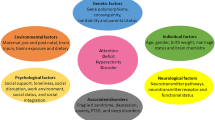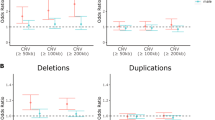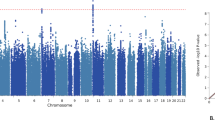Abstract
Recent research has suggested that serotonin, in addition to dopamine, may be involved in the development of attention deficit hyperactivity disorder (ADHD). Serotonin regulates dopaminergic neurotransmission in some areas of the brain via several 5-HT receptors including 5-HT1B. Animal studies have suggested the involvement of the 5-HT1B receptors in locomotor behaviour. For these reasons, we hypothesized that the 5-HT1B receptor gene may be a good candidate for genetic studies of ADHD. We tested for linkage disequilibrium between the 5-HT1B G861C polymorphism and ADHD in 115 families using the transmission disequilibrium test (TDT). We found evidence for a trend towards excess transmission of the 861G allele (χ2=2.91, P=0.09) that when further analysed for parental allele transmissions exhibited significantly greater paternal transmission of the G allele (χ2=4.80, P=0.03) to the affected child. Although preliminary, results from this study provide additional evidence that serotonin genes may be important risk factors for the development of ADHD.
This is a preview of subscription content, access via your institution
Access options
Subscribe to this journal
Receive 12 print issues and online access
$259.00 per year
only $21.58 per issue
Buy this article
- Purchase on Springer Link
- Instant access to full article PDF
Prices may be subject to local taxes which are calculated during checkout
Similar content being viewed by others

References
Gainetdinov RR, Wetsel WC, Jones SR, Levin ED, Jaber M, Caron MG . Role of serotonin in the paradoxical calming effect of psychostimulants on hyperactivity. Science 1999; 283: 397–401.
Quist JF, Kennedy JL . Genetics of childhood disorders XXIII. ADHD, Part 7: the serotonin system. J Am Acad Child Adolesc Psychiatry 2001; 40: 253–256.
Quist JF, Barr CL, Schachar R, Roberts W, Malone M, Tannock R et al. Evidence for the serotonin HTR2A receptor gene as a susceptibility factor in attention deficit hyperactivity disorder (ADHD). Mol Psychiatry 2000; 5: 537–541.
Halperin JM, Sharma V, Siever LJ, Schwartz ST, Matier K, Wornell G et al. Serotonergic function in aggressive and nonaggressive boys with attention deficit hyperactivity disorder. Am J Psychiatry 1994; 151: 243–248.
Halperin JM, Newcorn JH, Kopstein I, McKay KE, Schwartz ST, Siever LJ et al. Serotonin, aggression, and parental psychopathology in children with attention-deficit hyperactivity disorder. J Am Acad Child Adolesc Psychiatry 1997; 36: 1391–1398.
Halperin JM, Newcorn JH, Schwartz ST, Sharma V, Siever LJ, Koda VH et al. Age-related changes in the association between serotonergic function and aggression in boys with ADHD. Biol Psychiatry 1997; 41: 682–689.
Kruesi MJ, Hibbs ED, Zahn TP, Keysor CS, Hamburger SD, Bartko JJ et al. A 2-year prospective follow-up study of children and adolescents with disruptive behavior disorders. Prediction by cerebrospinal fluid 5-hydroxyindoleacetic acid, homovanillic acid, and autonomic measures? Arch Gen Psychiatry 1992; 49: 429–435.
Kruesi MJ, Rapoport JL, Hamburger S, Hibbs E, Potter WZ, Lenane M et al. Cerebrospinal fluid monoamine metabolites aggression and impulsivity in disruptive behavior disorders of children and adolescents. Arch Gen Psychiatry 1990; 47: 419–426.
Stoff DM, Pasatiempo AP, Yeung J, Cooper TB, Bridger WH, Rabinovich H . Neuroendocrine responses to challenge with dl-fenfluramine and aggression in disruptive behavior disorders of children and adolescents. Psychiatry Res 1992; 43: 263–276.
Lucki I . The spectrum of behaviors influenced by serotonin. Biol Psychiatry 1998; 44: 151–162.
Kelland MD, Chiodo LA . Serotonergic modulation of midbrain dopamine systems. In: Charles R, Ashby J (eds). The Modulation of Dopaminergic Neurotransmission by Other Neurotransmitters. CRC Press, Inc.: Boca Raton, FL, 1996; pp 87–122.
Barnes NM, Sharp T . A review of central 5-HT receptors and their function. Neuropharmacology 1999; 38: 1083–1152.
Ozaki N, Manji H, Lubierman V, Lu SJ, Lappalainen J, Rosenthal NE et al. A naturally occurring amino acid substitution of the human serotonin 5- HT2A receptor influences amplitude and timing of intracellular calcium mobilization. J Neurochem 1997; 68: 2186–2193.
Brunner D, Hen R . Insights into the neurobiology of impulsive behavior from serotonin receptor knockout mice. Ann N Y Acad Sci 1997; 836: 81–105.
Brunner D, Buhot MC, Hen R, Hofer M . Anxiety, motor activation, and maternal–infant interactions in 5HT1B knockout mice. Behav Neurosci 1999; 113: 587–601.
Saudou F, Amara DA, Dierich A, LeMeur M, Ramboz S, Segu L et al. Enhanced aggressive behavior in mice lacking 5-HT1B receptor. Science 1994; 265: 1875–1888.
Sarhan H, Cloez-Tayarani I, Massot O, Fillion MP, Fillion G . 5-HT1B receptors modulate release of [3]Hdopamine from rat striatal synaptosomes. Naunyn Schmiedebergs Arch Pharmacol 1999; 359: 40–47.
Ng NK, Lee HS, Wong PT . Regulation of striatal dopamine release through 5-HT1 and 5-HT2 receptors. J Neurosci Res 1999; 55: 600–607.
Boulenguez P, Rawlins JN, Chauveau J, Joseph MH, Mitchell SN, Gray JA . Modulation of dopamine release in the nucleus accumbens by 5-HT1B agonists: involvement of the hippocampo-accumbens pathway. Neuropharmacology 1996; 35: 1521–1529.
Iyer RN, Bradberry CW . Serotonin-mediated increase in prefrontal cortex dopamine release: pharmacological characterization. J Pharmacol Exp Ther 1996; 277: 40–47.
Sidenberg DG, Bassett AS, Demchyshyn L, Niznik HB, Macciardi F, Kamble AB et al. New polymorphism for the human serotonin 1D receptor variant (5-HT1D beta) not linked to schizophrenia in five Canadian pedigrees. Hum Hered 1993; 43: 315–318.
Lappalainen J, Dean M, Charbonneau L, Virkkunen M, Linnoila M, Goldman D . Mapping of the serotonin 5-HT1D beta autoreceptor gene on chromosome 6 and direct analysis for sequence variants. Am J Med Genet 1995; 60: 157–161.
Nothen MM, Erdmann J, Shimron-Abarbanell D, Propping P . Identification of genetic variation in the human serotonin 1D beta receptor gene. Biochem Biophys Res Commun 1994; 205: 1194–2001.
Huang YY, Grailhe R, Arango V, Hen R, Mann JJ . Relationship of psychopathology to the human serotonin1B genotype and receptor binding kinetics in postmortem brain tissue. Neuropsychopharmacology 1999; 21: 238–246.
Paterson AD, Naimark DM, Petronis A . The analysis of parental origin of alleles may detect susceptibility loci for complex disorders. Hum Hered 1999; 49: 197–204.
Schachar R, Wachsmuth R . Parent interview for child symptoms-revised DSM-IIIR. The Department of Psychiatry, The Hospital for Sick Children, Toronto, 1989.
Schachar R, Tannock R . Teacher telephone interview-revised DSM-IIIR. The Department of Psychiatry, The Hospital for Sick Children, Toronto, 1990.
Schachar R, Tannock R, Marriott M, Logan G . Deficient inhibitory control in attention deficit hyperactivity disorder. J Abnorm Child Psychol 1995; 23: 411–437.
Sham PC, Curtis D . An extended transmission/disequilibrium test (TDT) for multi allele marker loci. Ann Hum Genet 1995; 59: 323–336.
Author information
Authors and Affiliations
Corresponding author
Rights and permissions
About this article
Cite this article
Quist, J., Barr, C., Schachar, R. et al. The serotonin 5-HT1B receptor gene and attention deficit hyperactivity disorder. Mol Psychiatry 8, 98–102 (2003). https://doi.org/10.1038/sj.mp.4001244
Received:
Revised:
Accepted:
Published:
Issue Date:
DOI: https://doi.org/10.1038/sj.mp.4001244
Keywords
This article is cited by
-
Combined Influences of Genetic Factors and Attention Deficit Hyperactivity Disorder on the Development of Dependence on Synthetic Cannabinoids
Neuroscience and Behavioral Physiology (2020)
-
Association of Serotonin Receptors with Attention Deficit Hyperactivity Disorder: A Systematic Review and Meta-analysis
Current Medical Science (2018)
-
Expanding the toolbox of ADHD genetics. How can we make sense of parent of origin effects in ADHD and related behavioral phenotypes?
Behavioral and Brain Functions (2015)
-
Loss of neuronal 3D chromatin organization causes transcriptional and behavioural deficits related to serotonergic dysfunction
Nature Communications (2014)
-
Serotonin and molecular neuroimaging in humans using PET
Amino Acids (2012)


